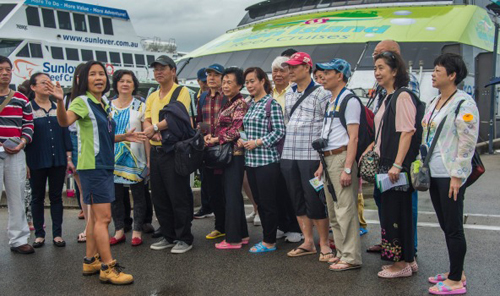Next month, China Eastern will start three direct flights a week to Sydney from Hangzhou.
More than 1.1 million Chinese visited Australia last year.
Next month China Eastern will start three direct flights a week to Sydney from Hangzhou. Hangzhou, a spectacular, vibrant city of 10 million people in southern China, is home to the e-commerce giant Alibaba and its founder Jack Ma.
Most Australians would never have heard of the city before Xi Jinping hosted an extravagant G20 summit there last month showcasing Chinese leadership, architecture and technology.
The director-general of the Hangzhou Tourism Commission, Li Hong, is excited about the prospect of attracting more Australians to visit his city. After all, about 45,000 Australians visited Hangzhou last year. Overwhelmingly, though, any new tourism influx will originate from the Chinese end.
That's because Hangzhou, even at 10 million, is only a relatively modest example of the extraordinary growth occurring in China's tourism, and there is more to come.
So far most of that surge is focused within China. In the country's Golden Week holiday last week, Li Hong points out that more than 15 million people visited Hangzhou. (Imagine what that would do to gridlock in a city like Sydney?) About 95 per cent were Chinese.
But that travel lens is extending further outwards and beyond China's borders.
"International travel has increasingly become an essential item on the shopping list of the middle class consumers in China," a recent Austrade report said. To much of the rest of the world it all seems rather sudden – but not in China.
My own packed Air China plane to Beijing provides a glimpse of that future, along with the inevitability that many of my fellow passengers have suitcases packed with tins of milk powder to take home.
Big numbers
Between them, Air China, China Southern and China Eastern carried 43 per cent of Chinese people coming to Australia, compared to 14 per cent for Qantas in 2015. The Chinese carriers' percentage will only increase.
But the force of numbers is already revolutionising Australia's tourism industry – just not fast enough to cope with the new demand and the certainty of much more.
Just how prepared Australia is for all this is far less certain. That includes managing already overstretched infrastructure, suitable accommodation and the ability to offer a range of experiences extending beyond traditional visits to hotspots like the Barrier Reef, the Sydney Opera House or the Great Ocean Road.
And then there is the more subtle question: how many tourists a year are enough? That seems like a good problem to have.
But some regional neighbours, including South Korea and Singapore, are beginning to complain about Chinese tourism overload. while the New York Times has described them as the globe's most resented tourists due to their numbers. Particularly at times like Golden Week or Chinese New Year, the strain on many of Australia's prime tourism attractions is obvious. At Hamilton Island just ahead of Chinese New Year, for example, western tourists, including Australians, definitely felt like bit players.
So what would a potential doubling of Chinese tourism numbers over the next four years look and feel like? We will undoubtedly find out. For now the Australian tourism industry remains desperate for more, more, more and is delighted to see this occurring for equally obvious reasons.
More than 1.1 million Chinese visited Australia last year, nearly double the number of British or US tourists and an increase of 23 per cent on the previous year. According to Austrade, that trend means they will easily overtake the traditional leader, New Zealand, by next financial year, two years ahead of predictions.
Chinese tourists spend more heavily than any other nationality. According to government figures they spent about $9 billion here in the year to June – compared to around $13 billion combined for visitors from the US, Britain, Japan, Korea, Singapore and Germany. By 2020, the Chinese tourism spend is predicted to add $13 billion a year to the economy
Regional benefits
But even those figures don't begin to explain the extent of the change that is happening globally. More than 120 million Chinese travelled internationally last year, putting Australia's share of just over one million into perspective. That number is expected to rise to 200 million by 2020. Given only about 3 per cent have passports, that may well be an underestimation.
And rather than such travel remaining heavily weighted towards familiar cultures like those of Hong Kong, Macau and Taiwan and, from there, to China's neighbours, many more Chinese tourists are now looking further afield.
That certainly benefits Australia with its reputation for natural beauty, beaches, wildlife, good shopping and great food and wine.
Tourism Australia surveyed Chinese consumers about their key considerations when choosing a destination. The study found that 49 per cent cited safety and security, 48 per cent world-class nature, 45 per cent cited food and wine, 41 per cent aquatic and coastal and 33 per cent mentioned value for money.
Although packaged tours are common, the category known as "free and independent travel" is becoming increasingly popular, especially with younger tourists – an indication that Chinese travellers are interested in different "experiences".
This suggests plenty of opportunity as well as mutual benefit in spreading tourism into regional areas rather than being concentrated in familiar spots. How much are these regional towns and tourism operators doing to attract and prepare for such potential growth? Wi-Fi anyone? Good service? Reliable standards?
What is clear is that Chinese love of social media means it will all be recorded, for better or worse. The reaction is likely to determine Australia's future share of a world tourism market now being seen through Chinese eyes.
